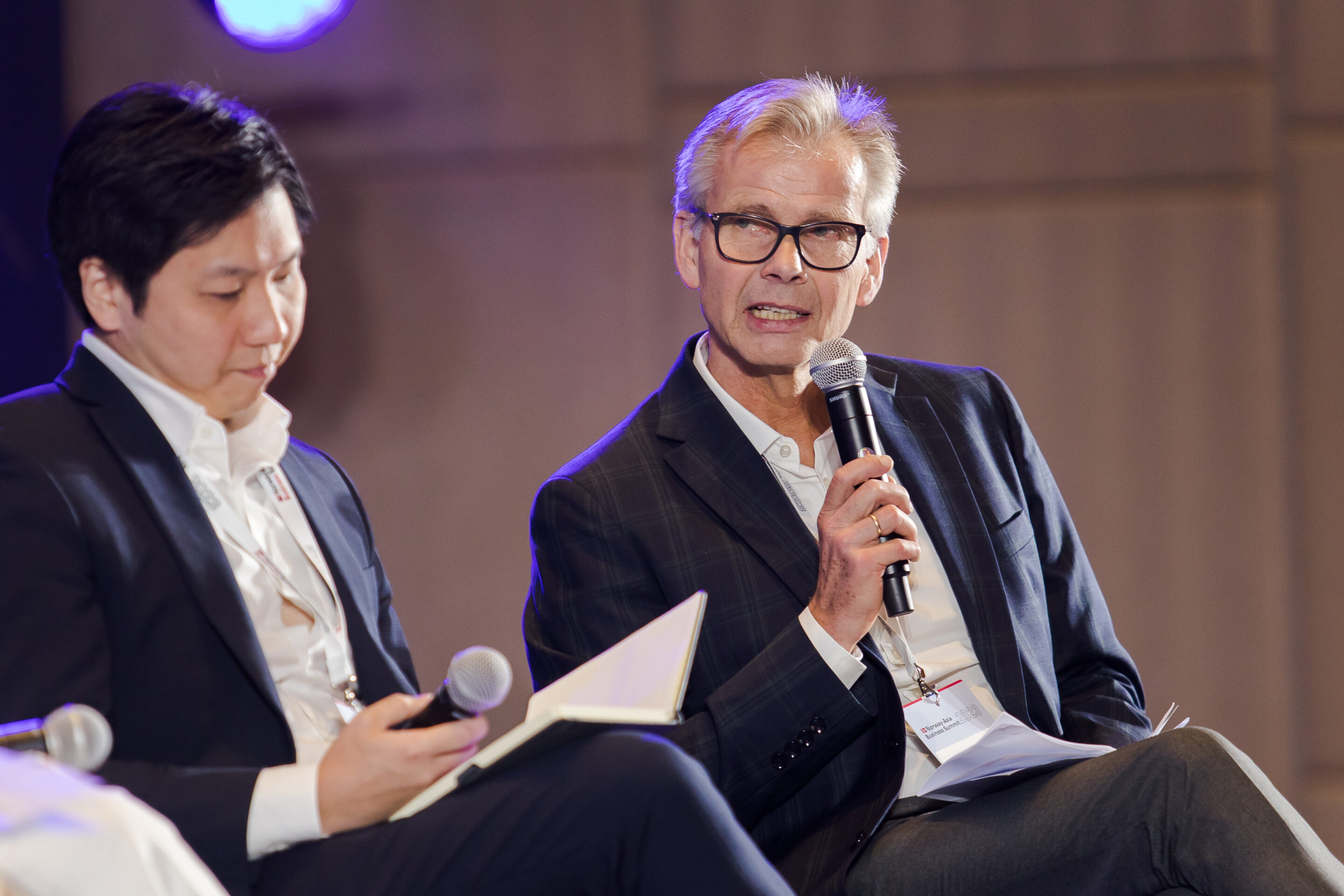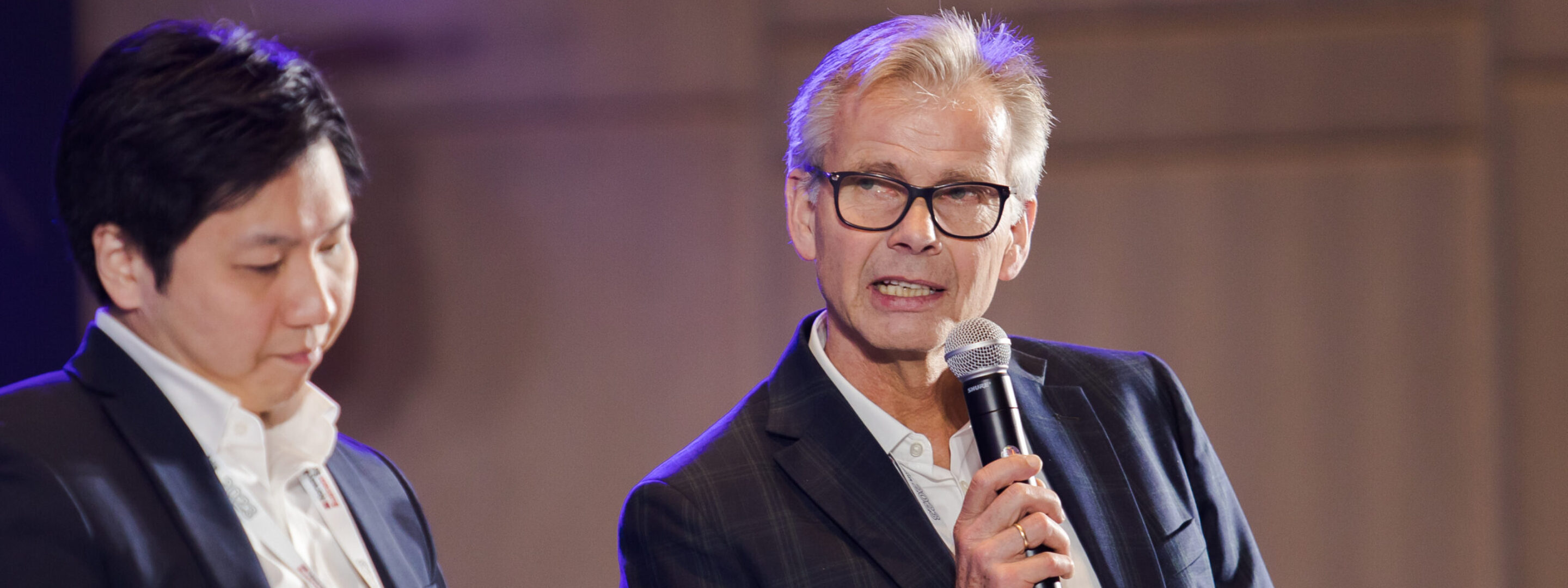Bridging Asia’s Digital Divide
Bridging Asia’s Digital Divide

During the Norwegian Asian Business Summit in Thailand, Ole Bjørn Sjulstad, Senior Vice President in Telenor Asia and Head of Investment Management Team for Thailand, spoke with Norway Asia Business Review about the importance of bridging the digital divide in Asia. With permission, we are pleased to publish the full interview below. View the original article here.
Two major mergers, along with the formation of an independent entity in Asia, has allowed Telenor to stay ahead of a rapidly changing telecom industry while fostering inclusive digital societies.
Data has become one of Asia’s most important resources. For instance, mobile data consumption is 5-6 times higher in Thailand and Malaysia compared to Norway. This is simply a start. In Telenor Asia’s Digital Lives Decoded 2023 survey, 70 percent of people asked said they expect to spend more time with their mobile phones in the coming years.
“For more than two decades, Telenor has witnessed firsthand how mobile connectivity has contributed to progress in the region. Asia has rapidly been catching up with its digital capabilities and now has a population that is fully connected, tech-savvy and avid users of digital services,” Mr Ole Bjørn Sjulstad, Senior Vice President and Head of Investment Management Thailand for Telenor Asia, states.
As demand for mobile data in Asia increases, bridging the digital divide and building inclusive digital societies becomes crucial. For more than a decade, Telenor has assisted in the development of digital skills. According to Mr Sjulstad, nearly six million youths, teachers and caregivers have been trained under these efforts.
“As the societies we operate in become fully connected, a critical component of an inclusive digital nation is to ensure that no individual, community or business is left behind. Enhancing digital skills among citisens is an important step in narrowing the usage gap by making everyone comfortable with a digital-first approach, enabling them to participate as creators and consumers of digital content,” Mr Sjulstad says.
An inability to bridge the digital divide can result in underserved portions of local populations being ill-equipped to deal with the risks that come with technological advances.
“We must recognise that new technologies also bring new challenges related to security, safety, ethics and inclusion,” Mr Sjulstad reports. “These are areas where telecom and technology providers need to work together with governments to develop policies and regulations that deliver benefits for people, businesses and society.”
Connectivity collaboration can unlock widespread growth in Asia as the digital transformation opens many opportunities for stakeholders at all levels.
“Asia is home to more than half of the world’s population, and consumers across the region are very open to adopting new technology,” Mr Sjulstad explains. “Telenor Asia is ideally positioned to lead the operating companies to deliver maximum impact and value to its customers.”
Like all telecom companies, Telenor Asia has invested significantly in infrastructure to provide high-quality and reliable networks vital to these digital aims. That is hardly surprising given the company’s first-mover spirit which saw it enter Asia 25 years ago.
“Telenor has been successful in Asia because we have managed to stay ahead of rapid changes in the region. In the beginning, it was all about providing mobile connectivity to the mass market,” Mr Sjulstad details. “Our entry into Asia was built on the belief that mobile connectivity would benefit everyone, and in the early years, we redesigned the distribution model and product offerings to make sure voice and data services were available and affordable for all.”
As markets matured in Asia, Telenor shifted its focus towards driving operational efficiency and delivering profitable growth. As a first mover, the company utilised new digital technology that introduced automation and touch-free operations, improving efficiency, lowering costs and providing better customer experiences in the process. The telecom landscape is changing again, and Telenor is ahead of the pack once more.
“When we saw the first signs of how new digital technologies would change the telecom industry, we entered new partnerships that would give us the scale and leadership positions necessary to bring new services and innovations to local markets,” Mr Sjulstad points out.
Major moves
Telenor reshaped its operations through a series of key moves over a six-month period beginning in October 2022. This began with Telenor Asia setting up an independent entity with full oversight and responsibility for the company’s operations in Bangladesh, Malaysia, Pakistan and Thailand from its headquarters in Singapore.

Next up was the completion of Southeast Asia’s two largest telecom mergers in history. In Malaysia, a merger between Celcom and Digi was concluded in November 2022. Then in March 2023, True Corporation, a merger between True and dtac, was launched in Thailand.
“Having completed two major mergers in Thailand and Malaysia, Telenor companies now hold leading market positions in three of the four Asian countries we operate in,” Mr Sjulstad says. “Our top priority this year has been to ensure the merged companies are integrating successfully and synergies are well executed. We are also working closely with Grameenphone in Bangladesh, where we already have the scale needed to further improve on our leading position, and with Telenor Pakistan to keep momentum in the local market there.”
With the companies in Asia now organised under Telenor Asia, an emphasis has been placed on scaling a profitable business while managing risk more efficiently.
“The ambition is to drive digitalisation and run new innovative services for both businesses and consumers. We will do this together with partners. With scale, we are better positioned to work with large international technology companies and global internet giants,” Mr Sjulstad explains. “Through leading local operations, we also play an important role in fuelling local ecosystems, enabling digital entrepreneurs and tech startups. A thriving digital economy will strengthen the region’s position as a digital hub and destination for investment.”
After a flurry of activity, most of 2023 has been spent ensuring the merged companies are integrating successfully with synergies being well executed.
While merger negotiations, preparation and planning had been ongoing for years, the real work started when the new companies were launched. Building a new common company culture combining the best from both parties was a priority since CelcomDigi and True Corporation involved what Mr Sjulstad calls “mergers of equals.”
“This process has forced us to evaluate everything we have done in the past and make conscious choices on what identity, culture and way of work we want for the future. We are moving from a traditional telco to digital telco-tech companies, so the way we operate needs to change as well,” Mr Sjulstad notes. “These processes are good, as they create a situation where everything can be questioned to find optimal solutions before a new culture and way of work is established.”
Rapid transformation
The mergers and decision to allow Telenor Asia to operate as an independent entity have happened at a time when advancements are being made at a breakneck pace. Mr Sjulstad cites this as the beginning of the next growth wave for the telecom industry with multiple technologies coming together simultaneously.
“We are potentially facing the largest digital transformation the world has ever seen, as connectivity will not just be between people, but also between billions of devices,” Mr Sjulstad states. “By bringing these technologies together we can create new opportunities for businesses and society. Whenever we talk about smart cities, smart homes, smart cars, smart factories or smart agriculture, a combination of connectivity and these other technologies are involved.”
Mr Sjulstad acknowledges that most work in this area is still in the early stages but believes the potential is clear. Currently, Telenor companies are running multiple pilot projects as it explores ways to build new services or improve efficiency in key sectors.
Sustainability matters
Between mergers, rapid technology transformations and a host of other matters, something such as sustainability can get lost in the shuffle. That is not the case at Telenor, which sees responsible business as a cornerstone for the company.
“Being a sustainable company in practice isn’t one or two things. It’s everything we do. We recognise the transformative power of connectivity and digitisation. We are guided by international standards and operational experience. We work systematically to address risk and maximise the positive impact of our services,” Mr Sjulstad emphasises.
He concludes, “We have set clear ambitions for 2025 to deliver on our science-based climate targets and be an environmental enabler for our partners; drive social and digital inclusion by promoting skill for the future and work diversity; upholding high standards of governance; and to be the preferred partner for digitalisation and corporate cyber security.”
Fact Box
- In October 2022, Telenor Asia set up regional headquarters in Singapore with full oversight and responsibility for the company’s operations in Bangladesh, Malaysia, Pakistan and Thailand
- Telenor completed Southeast Asia’s two largest telecom mergers, launching CelcomDigi in Malaysia and True Corporation in Thailand
- Grameenphone in Bangladesh and Telenor Pakistan are also under Telenor Asia
- Nearly six million youths, teachers and caregivers have been trained by Telenor on digital skills
- 70 percent of people asked by Telenor Asia expect to spend more time with their mobile phones in the coming years
- Telenor is committed to building inclusive digital societies that can bridge the digital divide in local markets.

